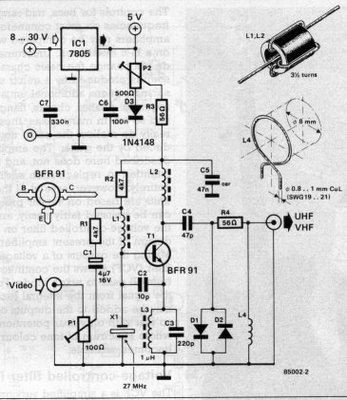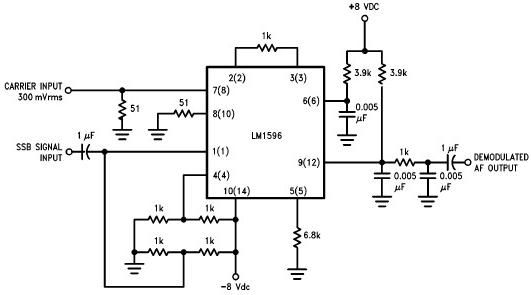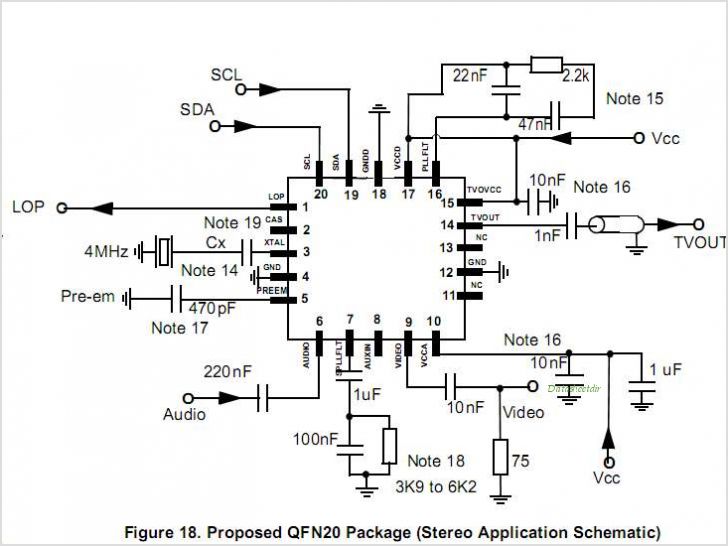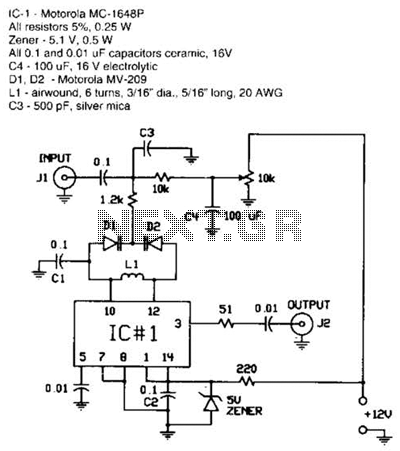
RF modulator
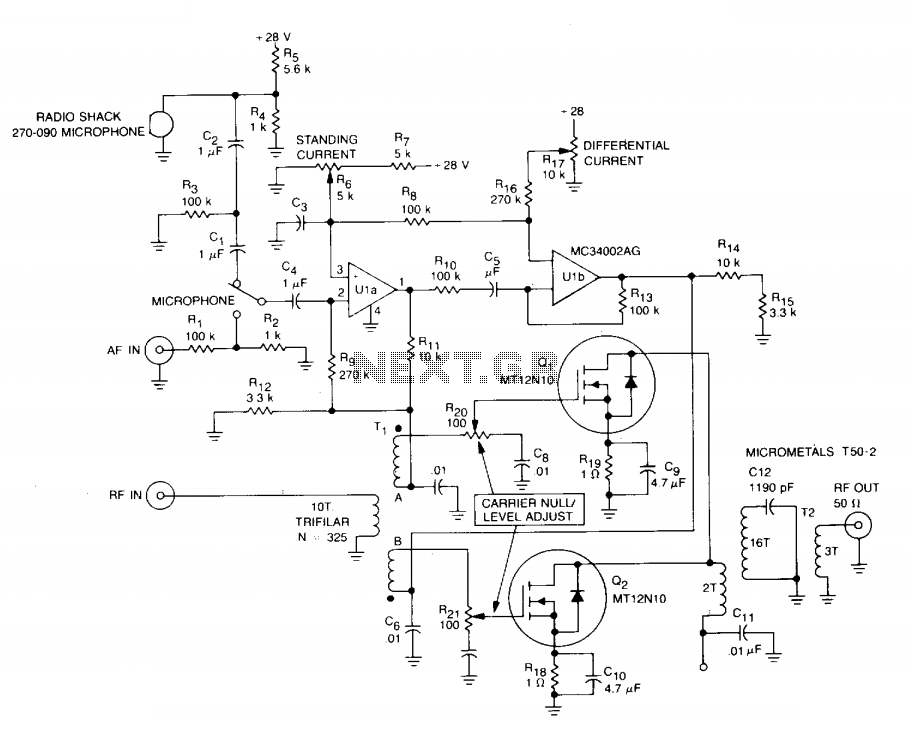
An RF input is applied to the primary of transformer T1, which provides equal amplitude, opposite phase RF drive to output FETs Q1 and Q2. In the absence of AF modulation at points A and B, the opposite phase RF signals cancel each other, resulting in no output at the 50 V output connector. When AF modulation is introduced at points A and B, a modulated RF output is generated. The DC stability and low-frequency gain are enhanced by source resistors R18 and R19. Additionally, a phase inverter composed of a dual op-amp (U1a and U1b) generates the out-of-phase, equal amplitude AF modulation signals.
The circuit operates by utilizing transformer T1, which is critical for coupling the RF input to the field-effect transistors (FETs) Q1 and Q2. These transistors are configured to handle the RF signals effectively, ensuring that when they are driven with equal amplitude but opposite phase signals, they will cancel each other out at the output when AF modulation is absent.
The introduction of audio frequency (AF) modulation at points A and B alters the phase relationship between the signals fed to the FETs. This modulation is crucial for generating a usable RF output, as it allows for the combination of the two signals in such a way that they no longer cancel each other out, but instead produce a modulated RF signal at the output.
The inclusion of resistors R18 and R19 serves to improve the overall stability of the DC operating point of the circuit, while also enhancing the low-frequency gain. These resistors provide a feedback mechanism that stabilizes the transistors' operation, preventing distortion and ensuring that the circuit maintains its performance across varying input conditions.
The phase inverter, utilizing dual op-amps U1a and U1b, plays a significant role in producing the necessary out-of-phase AF modulation signals. This configuration allows for precise control of the modulation depth and ensures that the signals fed to the FETs are properly balanced, which is essential for the effective operation of the RF output stage.
Overall, this circuit design exemplifies a well-engineered approach to RF amplification and modulation, utilizing key components such as transformers, FETs, resistors, and op-amps to achieve a reliable and efficient output.An RF input is applied to the primary of Tl, which applies equal amplitude, opposite phase RF drive for output FETs Ql and Q2. With no AF modulation at points A and B, the opposite phase RF signals cancel each other and no output appears at the 50 V output connector.
When AF modulation is applied to points A and B, a modulated RF output is obtained. The dc stability and low frequency gain are improved by source resistors R18 and R19. A phase inverter consisting of a dual op amp (Ula and Ulb) produces the out-of-phase, equal amplitude AF modulation signals.
The circuit operates by utilizing transformer T1, which is critical for coupling the RF input to the field-effect transistors (FETs) Q1 and Q2. These transistors are configured to handle the RF signals effectively, ensuring that when they are driven with equal amplitude but opposite phase signals, they will cancel each other out at the output when AF modulation is absent.
The introduction of audio frequency (AF) modulation at points A and B alters the phase relationship between the signals fed to the FETs. This modulation is crucial for generating a usable RF output, as it allows for the combination of the two signals in such a way that they no longer cancel each other out, but instead produce a modulated RF signal at the output.
The inclusion of resistors R18 and R19 serves to improve the overall stability of the DC operating point of the circuit, while also enhancing the low-frequency gain. These resistors provide a feedback mechanism that stabilizes the transistors' operation, preventing distortion and ensuring that the circuit maintains its performance across varying input conditions.
The phase inverter, utilizing dual op-amps U1a and U1b, plays a significant role in producing the necessary out-of-phase AF modulation signals. This configuration allows for precise control of the modulation depth and ensures that the signals fed to the FETs are properly balanced, which is essential for the effective operation of the RF output stage.
Overall, this circuit design exemplifies a well-engineered approach to RF amplification and modulation, utilizing key components such as transformers, FETs, resistors, and op-amps to achieve a reliable and efficient output.An RF input is applied to the primary of Tl, which applies equal amplitude, opposite phase RF drive for output FETs Ql and Q2. With no AF modulation at points A and B, the opposite phase RF signals cancel each other and no output appears at the 50 V output connector.
When AF modulation is applied to points A and B, a modulated RF output is obtained. The dc stability and low frequency gain are improved by source resistors R18 and R19. A phase inverter consisting of a dual op amp (Ula and Ulb) produces the out-of-phase, equal amplitude AF modulation signals.
